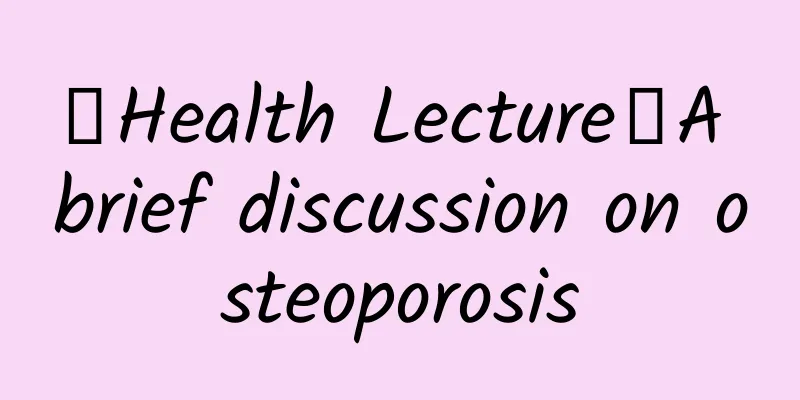【Health Lecture】A brief discussion on osteoporosis

|
1. Osteoporosis mainly refers to the decrease in bone density and bone quality due to various reasons. These factors will cause the patient's bone microstructure to be destroyed, increase the brittleness of the bones, and make the whole body prone to fractures. As my country enters an aging society, the impact of osteoporosis on public health is becoming increasingly serious. This article will give you a comprehensive understanding of the disease of osteoporosis! 2. How does bone mass change throughout a person’s life? 3. What kind of disease is osteoporotic fracture? 4. Why does osteoporosis occur? The occurrence of osteoporosis is related to many factors, mainly including the following aspects: (1) The decrease in sex hormone secretion in middle-aged and elderly people, especially the decrease in estrogen levels in women after menopause, is one of the important causes of osteoporosis and can lead to increased bone resorption. (2) With age, the secretion of calcium-regulating hormones becomes dysregulated, leading to bone metabolism disorders. (3) Elderly people have poor eating habits and eat less, and often have insufficient intake of protein, calcium, phosphorus, vitamins and trace elements. (4) Reduced outdoor exercise is also an important reason why the elderly are more susceptible to osteoporosis. 5. Is osteoporosis caused by calcium deficiency? 6. What are the categories of osteoporosis? 7. What are the main symptoms of osteoporosis? 8. How to treat osteoporosis? There are three clinical treatment methods for osteoporosis. (1) In clinical practice, basic measures are taken to treat osteoporosis, mainly to adjust the patient's lifestyle and guide the patient to balance their diet. The key is to increase protein intake, reduce salt intake, and enhance the absorption of such substances. Allow patients to engage in outdoor activities, such as aerobic exercise such as jogging. Ensure that bones are fully exercised. This method helps patients recover. Change bad living habits, such as smoking, drinking, and taking medications that affect bones. Necessary measures should be taken to prevent patients from falling, such as tidying up the environment, installing protective devices, laying anti-slip mats on the floor or tiles, and installing handrails in the bathroom to prevent falls. In order to improve the patient's bone health, bone supplements should be added, mainly in the form of calcium supplements. my country has made clear regulations on the amount of calcium intake for the elderly. Postmenopausal women and the elderly should ensure that their calcium intake is 1000 mg per person per day. About 400 mg can be ingested in the diet, so the calcium supplement should be guaranteed to be around 500 mg. There are also clear requirements for the intake of vitamins, and the elderly should ensure that the dosage is around 700 IU. These two supplements play an important role in preventing falls in the elderly. (2) Drug intervention Drug treatment is mainly used. Screening should be conducted for patients who have already suffered fractures or have osteoporosis risk factors. Anti-bone resorption drugs are mainly used, such as bisphosphonates, with alendronate and calcitonin as representative drugs. These drugs are mainly suitable for patients who do not have any pain. Or estrogen drugs can be used, which are only suitable for women. When using such drugs, the risks of such drugs should be fully assessed, and if abnormal reactions occur, medical treatment should be sought in time. Or taking drugs containing drugs that promote bone formation, mainly parathyroid drugs, the treatment time for patients should not exceed two years. Patients should take intramuscular injections. During treatment, patients should monitor their blood calcium levels in a timely manner to prevent hypercalcemia. Patients can also take strontium salts, ensuring that they are taken before bedtime. (3) Clinical surgical treatment. This treatment method can be divided into three categories: minimally invasive surgery, comminuted fractures, and hip fracture treatment. Minimally invasive surgery mainly refers to percutaneous vertebroplasty and kyphoplasty. These two minimally invasive surgeries are new advances in minimally invasive spinal treatment. Hip fractures are treated with minimally invasive surgery and closed reduction intertan internal fixation. They are suitable for various hip fractures and have the advantages of less trauma, faster recovery, and fewer complications. Patients with comminuted fractures are mostly elderly patients. Due to their osteoporosis, comminuted fractures occur in the distal end of the ulna and radius. This fracture will cause the articular surface to be affected to a certain extent. The treatment method in clinical practice is manual reduction, and splints and plaster are used to fix the injured part. If the patient has factors that cause unstable fractures, surgery is performed. Therefore, osteoporosis should be treated with prevention, combined with treatment and regular examination of bone biochemical indicators and bone density to detect abnormalities early and intervene as soon as possible. We have been carrying out standardized treatment of osteoporosis in elderly patients for a long time, using drugs and other lifestyle interventions to standardize the treatment of osteoporosis, improving the quality of life of the elderly and reducing the occurrence of osteoporosis complications. If you have the above symptoms of osteoporosis, please seek medical attention and standardized treatment as soon as possible. About the Author Tian Kangsong, attending physician, trauma orthopedics, West Campus of Zibo Central Hospital, master's degree student, member of the Communist Party of China, graduated from the National Key Department of Soochow University in 2010, majoring in orthopedics, has published three SCI papers and three utility model patents since he started working, and is an excellent teacher of Binzhou Medical College. He is currently a member of the Science Popularization Committee of the Chinese Medical Education Association, a member of the Orthopedics Professional Committee of the Shandong Pain Medicine Association, a member of the Orthopedics Youth Professional Committee of the Shandong Pain Medicine Association, and a member of the Trauma Surgery Committee of Zibo City. His main research directions: treatment of severe multiple injuries, complex bone and joint trauma, spinal trauma, etc., and he is good at: minimally invasive treatment of complex limb fractures. |
<<: Does gout, which does not cause pain, need to be treated?
>>: Women really need to eat more meat! The benefits are more than just a little bit!
Recommend
What are the benefits of swimming for women?
In summer, many people like to go to the beach or...
How can women protect their liver?
All the food we eat every day must be metabolized...
Warning | These types of cancer may be passed on to the next generation!
Cancer is not only affected by diet and environme...
The efficacy and function of Job's tears are powerful and are essential for dehumidification.
Job's tears is a very nutritious food with a ...
Can adenomyosis cause miscarriage?
Some of you may have heard of the symptoms of ade...
The louder the snoring, the higher the risk of infertility?
Obstructive sleep apnea (OSA) is commonly known a...
Teen girl vulva itching
Teenage girls have not yet fully developed, and t...
What is the name of Wu Bai's song "Want to See You"? Is Wu Bai's song "Want to See You" in the Taiwanese drama "Crossing the Fuse"?
How many people watched the Taiwanese drama "...
Why do I feel pain in my lower abdomen on the fifth day after miscarriage?
Miscarriage refers to a situation in which the fe...
Can damaged organs be repaired? "Human body 4S shop" is becoming a reality!
At the 37th "Healthy Line of Defense" l...
Female genitals smell
Everyone knows that female friends must pay atten...
Why do small blisters appear in private
Women's reproductive organs are also very sen...
The color of menarche and matters needing attention
The incidence of menstrual problems cannot be und...









